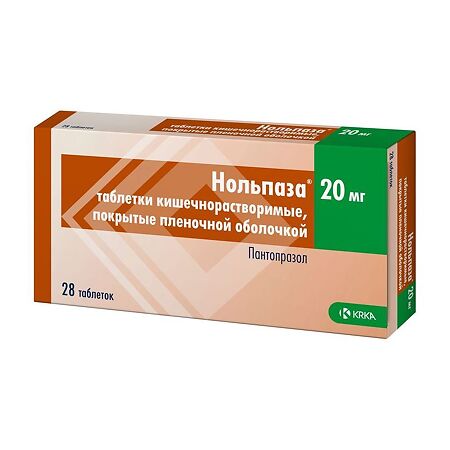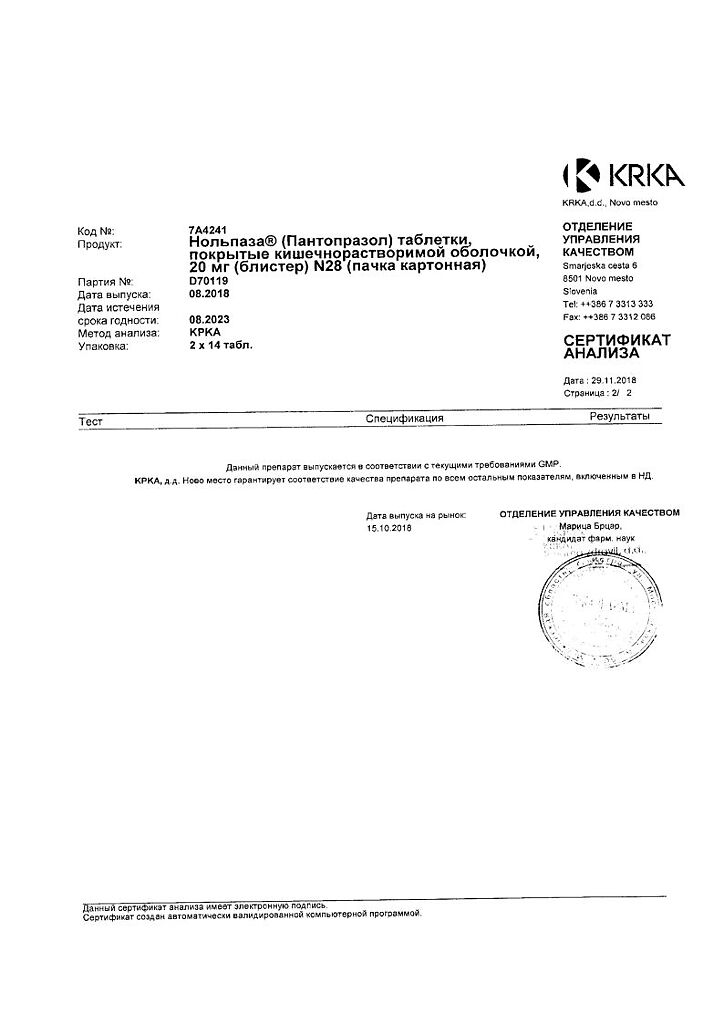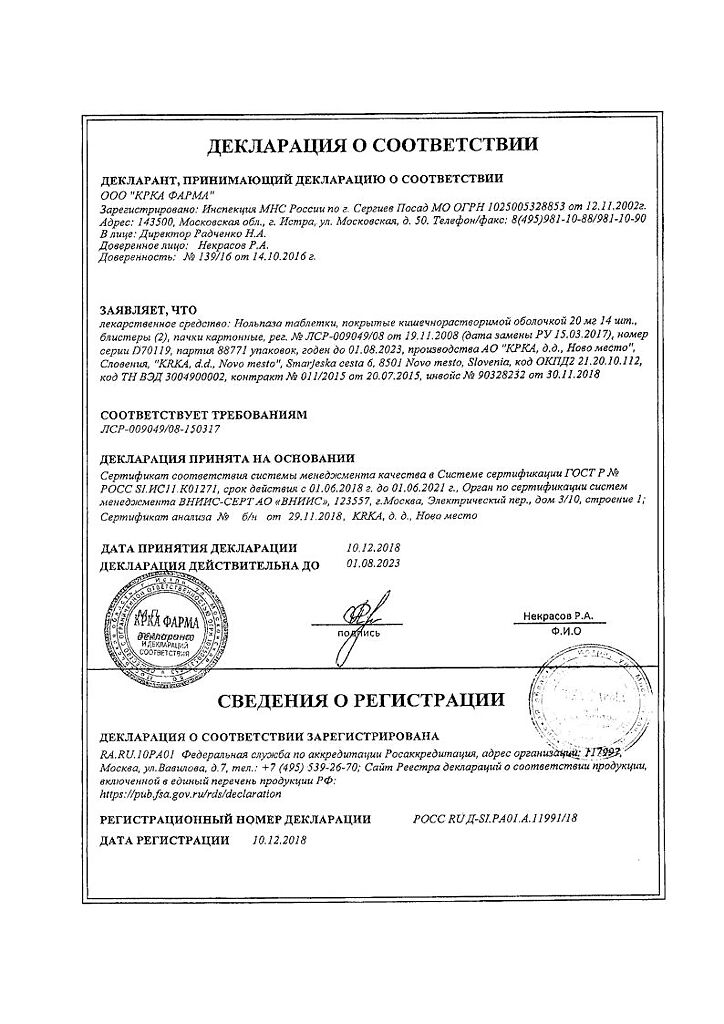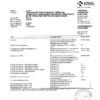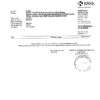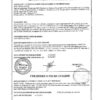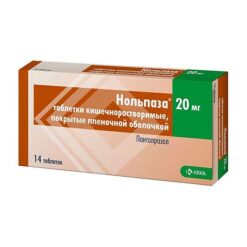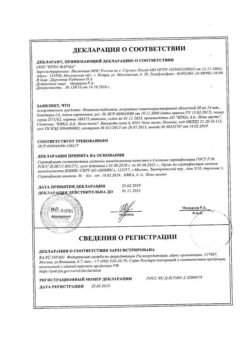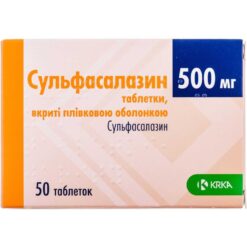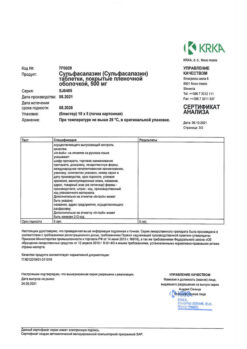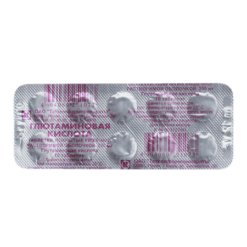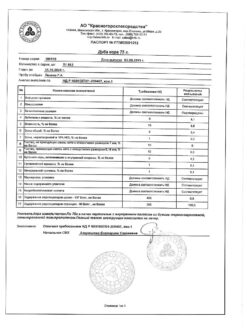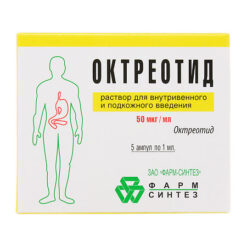No products in the cart.
Nolpaza, 20 mg 28 pcs.
€1.00
Out of stock
(E-mail when Stock is available)
EAN: 4610017700310
SKU: 211618
Categories: Medicine, Stomach, intestines, liver, Ulcer and gastritis
Description
Heartburn, Sour belching, GI infections caused by Helicobacter pylori, Nausea, Gastritis, Gastric and duodenal ulcers
Gastroesophageal reflux disease (GERD), including erosive ulcerative reflux esophagitis and GERD-associated symptoms: heartburn, acid regurgitation, pain on swallowing.
Gastric and duodenal ulcer (in the acute phase), erosive gastritis (including those associated with taking nonsteroidal anti-inflammatory drugs (NSAIDs)).
Zollinger-Ellison syndrome.
Eradication of Helicobacter pylori in combination with antibacterial agents.
Active ingredient
Active ingredient
Composition
Composition
for 1 tablet 20 mg/40 mg
for 1 tablet 20 mg/40 mg
Active substance:
Pantoprazole sodium sesquihydrate 22.55 mg/45.10 mg, equivalent to pantoprazole 20.00 mg/40.00 mg
Additives: mannitol, crospovidone, sodium carbonate, sorbitol, calcium stearate
Wrap film:
Hypromellose, povidone K-25, titanium dioxide (E171), iron oxide yellow dye (E172), propylene glycol, methacrylic acid and ethyl acrylate copolymer (1:1), 30% dispersion1, talc, macrogol-6000
1 Polymeric dispersion contains 0.7% sodium lauryl sulfate and 2.3% polysorbate-80 as emulsifiers.
How to take, the dosage
How to take, the dosage
The drug Nolpaza® is taken orally before meals, without chewing and crushing, with plenty of fluid.
GERD, including erosive ulcerative reflux esophagitis and GERD-associated symptoms: exgastric regurgitation, sour regurgitation, pain on swallowing:
mild degree:the recommended dose is 1 tablet of Nolpaza® (20 mg) per day;
medium and severe:the recommended dose is 1-2 tablets of the drug Nolpaza® 40 mg per day (40-80 mg/day). Relief of symptoms usually occurs within 2-4 weeks. The course of therapy is 4-8 weeks. For prophylaxis, as well as for long-term maintenance therapy, 20 mg daily (1 tablet of Nolpaz® 20 mg), if necessary, the dose is increased to 40-80 mg/day. It is possible to take the medicine “on demand” in case of symptoms.
Gastric and duodenal ulcer, erosive gastritis (including those associated with taking nonsteroidal anti-inflammatory drugs)
To 40-80 mg daily.
The course of treatment is 2 weeks at exacerbation of duodenal ulcer disease, if this time is not enough, healing can usually be achieved during the next 2 weeks of therapy. The course of treatment is 4-8 weeks at exacerbation of peptic ulcer disease and erosive gastritis.
Antiretroviral treatment of gastric and duodenal ulcer – 20 mg/day.
Eradication Helicobacter pylori
The following combinations are recommended:
The drug Nolpaza® 40 mg 2 times a day + amoxicillin 1000 mg 2 times a day + clarithromycin 500 mg 2 times a day.
The drug Nolpaza® 40 mg 2 times a day + metronidazole 500 mg 2 times a day + clarithromycin 500 mg 2 times a day.
The drug Nolpaza® 40 mg 2 times a day + amoxicillin 1000 mg 2 times a day + metronidazole 500 mg 2 times a day.
Treatment course is 7-14 days.
Zollinger-Ellison syndrome
For long-term therapy of Zollinger-Ellison syndrome and other pathological hypersecretory conditions, treatment should begin with a daily dose of 80 mg (2 tablets of Nolpaza® of 40 mg). Then, if necessary, the dose may be increased or decreased, depending on the acidity of gastric juices. Doses above 80 mg per day should be divided and used twice daily. A temporary increase in the dose of pantoprazole above 160 mg is possible, but should not be continued longer than necessary to achieve control of acidity. The duration of treatment in Zollinger-Ellison syndrome and other pathological hypersecretory conditions is not limited, and the duration of therapy may be determined depending on clinical necessity.
In patients with significant liver dysfunction, the daily dose of pantoprazole should not exceed 20 mg per day (1 tablet of Nolpaza® 20 mg). In this regard, the use of pantoprazole at a dose of 40 mg in this group of patients is not recommended. The activity of “liver” enzymes should be monitored regularly during treatment with pantoprazole, especially during long-term use. In case of increased liver enzyme activity the treatment should be discontinued.
No dose adjustment is required in elderly patients and patients with renal failure.
Due to the lack of data on the use of Nolpase® as part of combination antimicrobial therapy against Helicobacter pylori in patients with impaired renal function and in patients with moderate to severe hepatic impairment, the drug should not be used.
Interaction
Interaction
The simultaneous use of other proton pump inhibitors or H2-histamine receptor blockers without medical advice is not recommended.
The simultaneous use of Nolpase® may decrease the absorption of drugs whose bioavailability is dependent on the pH of the stomach (e.g. ketoconazole, itraconazole, posaconazole and other drugs such as erlotinib).
During drug interaction studies, no clinically significant interactions were identified when pantoprazole was used in the following cases:
It is also noted that there is no clinically significant drug interaction with caffeine, ethanol, theophylline.
There are reports of elevated blood levels of methotrexate in some patients when it is used together in high doses (e.g., 300 mg) with IPN. Therefore, when using high doses of methotrexate, such as in cancer or psoriasis, it may be necessary to consider temporarily withdrawing pantoprazole.
CYP2C19 isoenzyme activity inhibitors such as fluvoxamine may increase systemic exposure to pantoprazole. Dose reduction may be necessary in patients receiving long-term treatment with high doses of pantoprazole or in patients with hepatic impairment.
Inducers of CYP2C19 and CYP3A4 isoenzyme activity such as rifampicin and Hypericum (Hypericum. perforatum), can decrease the plasma concentration of IPNs metabolized by these enzyme systems.
HIV protease inhibitors
Pantoprazole is not recommended for use with HIV protease inhibitors whose absorption is dependent on the pH of the gastric environment (e.g., atazanavir) because of a significant decrease in their bioavailability.
If co-administration of HIV protease inhibitors and IPNs is still necessary, careful clinical monitoring (e.g., viral load determination) is recommended. The dose of pantoprazole should not exceed 20 mg daily. Adjustment of HIV protease inhibitor dosage may also be necessary.
Special Instructions
Special Instructions
Hepatic failure, risk factors for cyanocobalamin (vitamin B12 deficiency (especially in the background of hypo- and achlorhydria).
It is contraindicated in persons under 18 years of age.
In patients with significant liver dysfunction the daily dose of pantoprazole should not exceed 20 mg per day (1 tablet of Nolpaza® 20 mg). In this regard, the use of pantoprazole at a dose of 40 mg in this group of patients is not recommended. The activity of “liver” enzymes should be monitored regularly during treatment with pantoprazole, especially during long-term use. In case of increased liver enzyme activity the treatment should be discontinued.
No dose adjustment is required in elderly patients and patients with renal failure.
Due to the lack of data on the use of Nolpase® as part of combination antimicrobial therapy against Helicobacter
Synopsis
Synopsis
Oval, slightly biconvex, film-coated tablets of light yellowish-brown color.
Fracture appearance: rough white to light yellowish brown mass with light yellowish brown film coating.
Contraindications
Contraindications
Side effects
Side effects
Approximately 5% of patients can be expected to develop adverse drug reactions (ADRs). The most common ADRs are diarrhea and headache, developing in approximately 1% of patients.
The following are the NCDs reported with pantoprazole, classified according to frequency of occurrence as follows:
Frequency cannot be categorized for adverse reactions identified during post-registration use of the drug and are therefore listed as “frequency unknown”.
Within each incidence group, adverse reactions are presented in decreasing order of severity.
Blood and lymphatic system disorders:
rarely: agranulocytosis;
very rarely: thrombocytopenia, leukopenia, pancytopenia.
Immune system disorders:
rarely: hypersensitivity (including anaphylactic reactions, including anaphylactic shock).
Metabolic and nutritional disorders:
rarely: hyperlipidemia and increased plasma lipid concentrations (triglycerides, cholesterol), body weight changes;
frequency unknown: hyponatremia, hypomagnesemia, hypocalcemia in combination with hypomagnesemia, hypokalemia.
Mental disorders:
infrequent: sleep disturbance;
rarely: depression (including exacerbations of existing disorders);
very rarely: disorientation (including exacerbations of existing disorders);
frequency unknown: hallucinations, confusion (especially in predisposed patients, and possible exacerbation of symptoms if present before using the drug).
Nervous system disorders:
infrequently: headache, dizziness;
rarely: dysgeusia (taste disorder);
frequency unknown: paresthesia.
Visual organ disorders:
rarely: visual disturbance/blurred vision.
Gastrointestinal tract disorders:
often: glandular polyps of the stomach floor (benign);
infrequent: diarrhea, nausea/vomiting, abdominal bloating and flatulence, constipation, dry oral mucosa, abdominal pain and discomfort;
frequency unknown: microscopic colitis.
Liver and biliary tract disorders:
infrequent: increased activity of “liver” enzymes (transaminases, γ-glutamyltransferase) in blood plasma;
rarely: increased plasma bilirubin concentration;
frequency unknown: hepatocellular damage, jaundice, hepatocellular failure.
Skin and subcutaneous tissue disorders:
infrequent: skin rash/exanthema/rash, skin itching;
rarely: urticaria, angioedema;
frequency unknown: erythema malignant exudative (Stevens-Johnson syndrome), toxic epidermal necrolysis (Lyell syndrome), erythema multiforme exudative, photosensitivity, subacute cutaneous lupus erythematosus (SLE).
Musculoskeletal and connective tissue disorders:
infrequently: fracture of the femoral neck, carpal or spinal bones;
rarely: arthralgia, myalgia;
frequency unknown: muscle spasm as a consequence of electrolyte imbalance.
Kidney and urinary tract disorders:
frequency unknown: interstitial nephritis (with possible progression to renal failure).
Gender and breast disorders:
rarely: gynecomastia.
General disorders and disorders at the site of administration:
infrequently: asthenia, excessive fatigue and malaise;
rarely: increased body temperature, peripheral edema.
Overdose
Overdose
No cases of overdose were observed as a result of using Nolpaza®.
Doses of pantoprazole up to 240 mg were administered intravenously within 2 min and were well tolerated.
In case of overdose and only when clinical manifestations appear, symptomatic and supportive therapy is given. Pantoprazole is not excreted by hemodialysis.
Pregnancy use
Pregnancy use
Pregnancy
As a precaution, the use of Nolpaza® during pregnancy should be excluded.
Breastfeeding period
Due to insufficient information on the use of Nolpaza® in women during breastfeeding, the potential risk to newborns and breastfed infants cannot be excluded. In this regard, it is necessary to decide whether to stop breastfeeding or to cancel/suspend treatment with Nolpaz®.
Fertility
There are no data on the effects of Nolpase® on fertility in humans. Preclinical studies have shown no effect on male or female fertility.
Similarities
Similarities
Additional information
| Weight | 0.021 kg |
|---|---|
| Shelf life | 5 years. Do not use the product after the expiration date. |
| Conditions of storage | At the temperature not more than 25 ºС, in the original package. Keep out of reach of children. |
| Manufacturer | KRKA-RUS, Russia |
| Medication form | enteric soluble tablets |
| Brand | KRKA-RUS |
Other forms…
Related products
Buy Nolpaza, 20 mg 28 pcs. with delivery to USA, UK, Europe and over 120 other countries.

